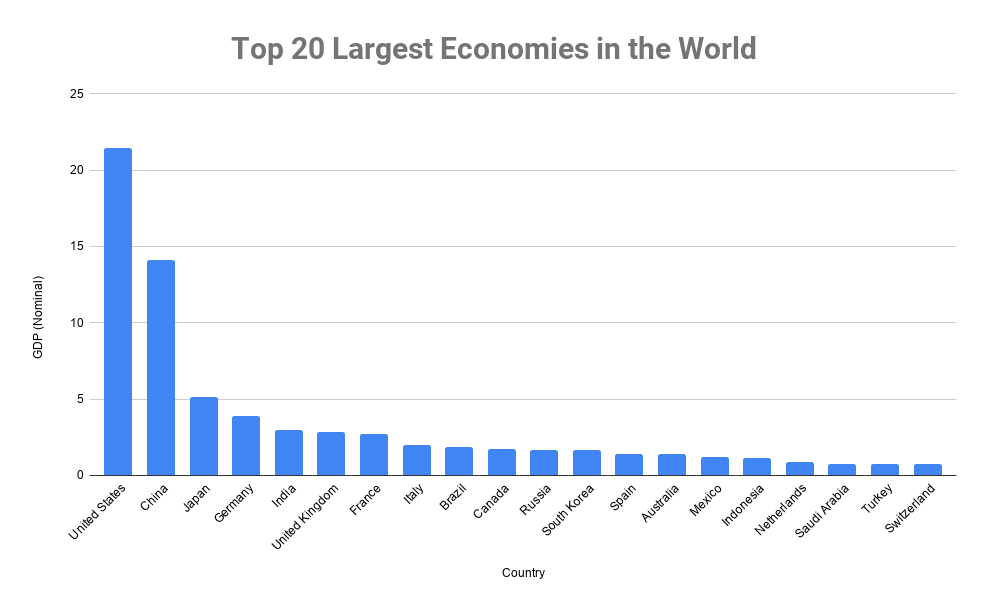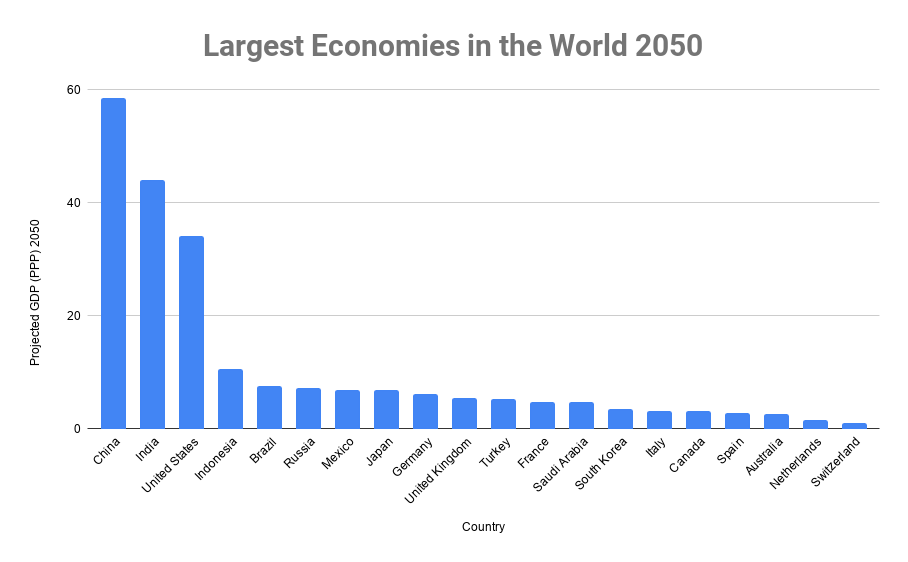Current State of the Largest Economies in the World
Ranking the top 10 largest economies in the world in 2020 is no easy task. Do we rank countries by GDP, or is there more to get a clearer picture of assessing the most dominant economies in the world now, and looking ahead. Just how big are the countries mentioned on this list? The nominal GDP of the top 10 economies in the world adds up to about 66% of the world’s economy, while the top 20 largest economies contribute almost 79%. By nominal GDP, The USA is the biggest economy in the world, followed by China and Japan. When factoring in the gross domestic product based on purchasing power parity, by 2050 both China and India will become the two largest economies in the world, with the US third. The power of economies is very important as it engages investment, trade, and business opportunities all over the world. The following is a list of the top 20 largest economies in the world in 2020 and beyond. Expect to gain insights on the following:
- What is the largest economy in the world in 2020?
- What will be the largest economy in the world by 2050?
- GDP by country
This list is based on the IMF’s World Economic Outlook Database
The current numbers and future projections cited are based on Nominal GDP = Gross domestic product, current prices, U.S. dollars; GDP based on PPP = Gross domestic product based on purchasing power parity; and 2050 GDP (PPP) projections.
Top 20 Largest Economies in the World 2020
What is the largest economy in the world in 2020? This is BizVibe’s complete list of the top 10 biggest economies in the world in 2020 by both nominal GDP and estimated gross domestic product based on purchasing power parity.
GDP By Country

Rank |
Country |
GDP (Nominal) |
GDP (PPP) |
2050 GDP Projections |
| 1 | United States | 21.44 | 21.44 | 34.1 |
| 2 | China | 14.14 | 27.31 | 58.49 |
| 3 | Japan | 5.15 | 5.75 | 6.77 |
| 4 | Germany | 3.86 | 4.44 | 6.13 |
| 5 | India | 2.94 | 10.51 | 44.12 |
| 6 | United Kingdom | 2.83 | 3.04 | 5.36 |
| 7 | France | 2.71 | 2.96 | 4.7 |
| 8 | Italy | 1.99 | 2.4 | 3.11 |
| 9 | Brazil | 1.85 | 3.37 | 7.54 |
| 10 | Canada | 1.73 | 1.84 | 3.1 |
| 11 | Russia | 1.64 | 4.21 | 7.13 |
| 12 | South Korea | 1.63 | 2.14 | 3.54 |
| 13 | Spain | 1.4 | 1.86 | 2.73 |
| 14 | Australia | 1.38 | 1.32 | 2.56 |
| 15 | Mexico | 1.22 | 2.57 | 6.86 |
| 16 | Indonesia | 1.11 | 3.5 | 10.5 |
| 17 | Netherlands | 0.9 | 0.97 | 1.49 |
| 18 | Saudi Arabia | 0.77 | 1.86 | 4.69 |
| 19 | Turkey | 0.74 | 2.29 | 5.18 |
| 20 | Switzerland | 0.71 | 0.55 | 1.01 |
1. United States
What is the largest economy in the world in 2020? Since 1871, the USA has retained its position as the largest economy in the world. The USA ranks number 1 in the world in nominal GDP (Gross domestic based on current prices), with a nominal GDP of USD 21.44 trillion — ahead of 2nd place China. When measured bu purchasing power parity (GDP based on PPP) however, the USA ranks 2nd behind China with a GDP (PPP) of USD 21.44 trillion. By 2023 the US economy is expected to grow to USD 24.88 trillion. By 2050, the US economy is projected to grow to USD 34.1 trillion.
The USA has the world’s eighth-highest per capita GDP (nominal) and the tenth-highest per capita GDP (PPP) currently. The USA is known for being one of the most technologically powerful economies in the world and its firms are at or near the forefront in technological advances, especially in computers, pharmaceuticals, and medical, aerospace, and military equipment.
- USA Nominal GDP Rank 2020: USD 21.44 trillion (1st)
- USA GDP (PPP) Rank 2020: USD 21.44 trillion (2nd)
- USA Estimated GDP Rank 2050: USD 34.1 trillion (3rd)
USA GDP by Component
- Household consumption: 68.4%
- Government consumption: 17.3%
- Investment in fixed capital: 17.2%
- Investment in inventories: 0.1%
- Exports of goods and services: 12.1%
- Imports of goods and services: −15%
USA GDP by Sector
- Agriculture: 0.9%
- Industry: 18.9%
- Services: 80.2%
2. China
Ranking 2nd on this list of the top 20 biggest economies in the world is China, an economy the has transitioned from a centrally-planned system to a more market-oriented economy since 1978. China has broken from a centrally planned economy that used to struggle to the manufacturing and exporting hub of the world. Based on nominal GDP, China is the 2nd largest economy in the world with a nominal GDP of USD 14.14 trillion. China has a gross domestic product based on purchasing power parity of USD 27.31 trillion, ranking number 1 among the top 20 largest economies in the world in 2020. When you account for the nation’s domestic market based on the relative cost of local goods, China has the largest GDP in the world.
How did China become one of the fastest-growing economies in the world in 2020? Well, China is the world’s largest manufacturing economy and exporter of goods. After the US, China has the world’s second-highest number of billionaires with a total wealth of USD 996 billion. China’s largest trading partners are the US, EU, Japan, Hong Kong, South Korea, India, Taiwan, Australia, Vietnam, Malaysia, and Brazil. By 2023, China’s nominal GDP is expected to grow to USD 19.41 trillion. Also by 2023, China’s GDP (PPP) is projected to grow to USD 36.99 trillion. And by 2050, China will lead the world in GDP with an estimated GDP of USD 58.499 trillion.
- China Nominal GDP Rank 2020: USD 14.14 trillion (2nd)
- China GDP (PPP) Rank 2020: USD 27.31 trillion (1st)
- China Estimated GDP Rank 2050: USD 58.49 trillion (1st)
China GDP by Component
- Household consumption: 39.1%
- Government consumption: 14.5%
- Investment in fixed capital: 42.7%
- Investment in inventories: 1.7%
- Exports of goods and services: 20.4%
- Imports of goods and services: −18.4%
China GDP by Sector
- Agriculture: 7.9%
- Industry: 40.5%
- Services: 51.6%
3. Japan
Japan ranks 3rd on our list of the top 20 largest economies in the world in 2020. Japan ranks 3rd behind the USA and China in nominal GDP at USD 5.15 trillion and 4th behind the USA, China, and India in GDP (PPP) at USD 5.75 trillion. The stimulus from the 2020 Olympics was supposed to add investments back into the economy after a rough stretch due to the earthquake and 2008 recession, however, that is yet to be seen due to the derailment of the Olympics due to the COVID-19 pandemic.
The economy of Japan is a highly developed free-market economy. Why is Japan’s economy so large? Japan is the world’s third-largest automobile manufacturing country and has the largest electronics goods industry, and is often ranked among the world’s most innovative countries leading several measures of global patent filings. Facing competition from China, South Korea, and Vietnam, Japan now focuses on high-tech and precision goods, such as optical instruments, hybrid vehicles, and robotics. Besides the Kantō region, the Kansai region is one of the leading industrial clusters and manufacturing centers for the Japanese economy. By 2050, Japan is expected to slip to 8th in global GDP rankings with an estimated GDP of USD 6.77 trillion in 2050.
- Japan Nominal GDP Rank 2020: USD 5.15 trillion (3rd)
- Japan GDP (PPP) Rank 2020: USD 5.75 trillion (4th)
- Japan Estimated GDP Rank 2050: USD 6.77 trillion (8th)
Japan GDP by Component
- Household consumption: 55.5%
- Government consumption: 19.6%
- Investment in fixed capital: 24%
- Investment in inventories: 0%
- Exports of goods and services: 17.7%
- Imports of goods and services: −16.8%
Japan GDP by Sector
- Agriculture: 1.1%
- Industry: 30.1%
- Services: 68.7%
4. Germany
Germany ranks 4th on this list of the top economies in the world. The economy of Germany is a highly developed social market economy. Germany has a nominal GDP of USD 3.86 trillion — making it the 4th largest economy in the world. By GDP (PPP), Germany ranks 5th in the world at USD 4.44 trillion behind the USA, China, India, and Japan. The German economy is dependent upon capital good exports, which suffered a setback post-2008 financial crisis.
Germany has the largest national economy in Europe. Why is the German economy so big? In 2016, Germany recorded the highest trade surplus in the world worth $310 billion,[26] making it the biggest capital exporter globally. Germany’s service sector contributes around 70% of the total GDP, industry 29.1%, and agriculture 0.9%. Exports account for 41% of national output. Germany is the world’s top location for trade fairs, with two-thirds of the world’s leading trade fairs, take place in Germany. By 2050, Germany’s economy is expected to slip to 9th place with a GDP of USD 6.13 trillion.
- Germany Nominal GDP Rank 2020: USD 3.86 trillion (4th)
- Germany GDP (PPP) Rank 2020: USD 4.44 trillion (5th)
- Germany Estimated GDP Rank 2050: USD 6.13 trillion (9th)
Germany GDP by Component
- Household consumption: 53.1%
- Government consumption: 19.5%
- Investment in fixed capital: 20.4%
- Investment in inventories: −0.5%
- Exports of goods and services: 47.3%
- Imports of goods and services: −39.7%
Germany GDP by Sector
- agriculture: 0.7%
- industry: 30.7%
- services: 68.6%
5. India
Indian is the 5th largest economy in the world ranked by nominal GDP at USD 2.94 trillion. Despite being characterized as a developing market economy, India is showing no slowing down in economic growth. By GDP (PPP), India is the 3rd largest economy in the world, with a GDP (PPP) of USD 10.51 trillion. From 2014 to 2018, Indian was the fastest-growing major economy in the world only, behind China. What makes Indian one of the biggest economies in the world in 2020? The long-term growth prospective of the Indian economy remains positive due to its young population and corresponding low dependency ratio, healthy savings, and investment rates, and its increasing integration into the global economy. India ranks second globally in food and agricultural production, while agricultural exports were $38.5 billion. By 2050, India is projected to become the 2nd largest economy in the world with a GDP (PPP) of USD 44.12 trillion.
- India Nominal GDP Rank 2020: USD 2.94 trillion (5th)
- India GDP (PPP) Rank 2020: USD 10.51 trillion (3rd)
- India Estimated GDP (PPP) Rank 2050: USD 44.12 trillion (2nd)
India GDP by Component
- Household consumption: 59.1%
- Government consumption: 11.5%
- Investment in fixed capital: 28.5%
- Investment in inventories: 3.9%
- Exports of goods and services: 19.1%
- Imports of goods and services: −22%
India GDP by Sector
- Agriculture: 15.4%
- Industry: 23%
- Services: 61.5%
6. United Kingdom
Ranking 6th on this list of the top 20 largest economies in the world is the United Kingdom. The UK ranks 6th with a nominal GDP of USD 2.83. By GDP by Purchasing Power Parity (PPP), The UK ranks 9th in GDP (PPP) at USD 3.04 trillion. The economy of the United Kingdom is a highly developed social market, with the economy being market-oriented. Why is the UK economy so big? The UK was the tenth-largest goods exporter in the world and the fifth-largest goods, importer. The service sector dominates, contributing around 80% of GDP; the financial services industry is particularly important, and London is the second-largest financial center in the world. By 2050, the UK is expected to slip to the 10th ranking by GDP (PPP) at USD 5.36 trillion.
- UK Nominal GDP Rank 2020: USD 2.83 trillion (6th)
- UK GDP (PPP) Rank 2020: USD 3.04 trillion (9th)
- UK Estimated GDP (PPP) Rank 2050: USD 5.36 trillion (10th)
UK GDP by Sector
- agriculture: 0.6%
- industry: 19.2%
- services: 80.2%
7. France
As of 2020, France ranks 7th on our list of the top 20 largest economies in the world with a nominal GDP of USD 2.71 trillion. France has a large tourism industry, as it’s the most-visited country in the world. France’s growth in terms of GDP based on purchasing power parity (PPP) is USD 2.96 — ranking 10th among the top economies in the world. The economy of France is highly developed and free-market-oriented.
Why is France’s economy so big? The chemical industry is a key sector for France, helping to develop other manufacturing activities and contributing to economic growth. France’s tourism industry is a major component of the economy, as France is the most visited destination in the world. In 2050, France’s economy is expected to reach a GDP (PPP) of USD 4.7 trillion — ranking 12th among this list of the biggest economies in the world.
- France Nominal GDP Rank 2020: USD 2.71 trillion (7th)
- France GDP (PPP) Rank 2020: USD 2.96 trillion (10th)
- France Estimated GDP Rank 2050: USD 4.7 trillion (12th)
France GDP by Sector
- agriculture: 1.7%
- industry: 19.5%
- services: 78.8%
8. Italy
Italy ranks 8th on this list of the top 10 largest economies in the world in 2020. Italy is the 8th largest economy in the world with a nominal GDP of USD 1.99 trillion; and a GDP (PPP) of 2.4 — ranking 12th there. Why is the Italian economy so big? Italy is a large manufacturer (overall the second in EU behind Germany) and exporter of a significant variety of products including machinery, vehicles, pharmaceuticals, furniture, food, clothing, and robots. Italy’s economy runs of large trades surpluses making it very successful. By 2050, Italy’s economy is projected to USD 3.11 trillion — ranking 21st among the top economies in the world in 2020.
- Italy Nominal GDP Rank 2020: USD 1.99 trillion (8th)
- Italy GDP (PPP) Rank 2020: USD 2.4 trillion (12th)
- Italy Estimated GDP (PPP) Rank 2050: USD 3.11 trillion (15th)
Italy GDP by Sector
- agriculture: 2.1%
- industry: 23.9%
- services: 73.9%
9. Brazil
Brazil ranks 9th on this list of the top 20 largest economies in the world with a nominal GDP of USD 1.85 trillion. Brazil also ranks 8th by gross domestic product by purchasing power parity at USD 3.37 trillion. Brazil has a developing mixed economy with a large agricultural, energy, and raw materials sector. From 2000 to 2012, Brazil was one of the fastest-growing major economies in the world, with an average annual GDP growth rate of over 5%. By 2050, Brazil is expected to become one of the top 5 economies in the world going by GDP (PPP); which is projected to reach USD 7.54 trillion.
- Brazil Nominal GDP Rank 2020: USD 1.85 trillion (9th)
- Brazil GDP (PPP) Rank 2020: USD 3.37 trillion (8th)
- Brazil Estimated GDP (PPP) Rank 2050: USD 7.54 trillion (5th)
Brazil GDP by Sector
- services: 76%
- industry: 18.5%
- agriculture: 5.5%
10. Canada
Canada ranks 10th on this list of the top 20 largest economies in the world in 2020. Canada is the 10th largest economy in the world with a nominal GDP of USD 1.73 trillion. By GDP (PPP), Canada ranks 17th at USD 1.84 trillion. The economy of Canada is a highly developed market economy. Why is Canada’s economy so big? Canada has the third-highest total estimated value of natural resources, valued at USD 33.2 trillion. Canada also has the world’s third-largest proven petroleum reserves and is the fourth largest exporter of petroleum. Canada is considered an “energy superpower” due to its abundant natural resources. By 2050 Canada’s economy is projected to grow to USD 3.1 trillion — ranking 16th among the biggest economies in the world.
- Canada Nominal GDP Rank 2020: USD 1.73 trillion (10th)
- Canada GDP (PPP) Rank 2020: USD 1.84 trillion (17th)
- Canada Estimated GDP (PPP) Rank 2050: USD 3.1 trillion (16th)
Canada GDP by Sector
- agriculture: 1.6%
- industry: 28.2%
- services: 70.2%
11. Russia:
- Russia Nominal GDP Rank 2020: USD 1.64 trillion (11th)
- Russia GDP (PPP) Rank 2020: USD 4.21 trillion (6th)
- Russia Estimated GDP (PPP) Rank 2050: USD 7.13 trillion (6th)
12. South Korea
- South Korea Nominal GDP Rank 2020: USD 1.63 trillion (12th)
- South Korea GDP (PPP) Rank 2020: USD 2.14 trillion (14th)
- South Korea Estimated GDP (PPP) Rank 2050: USD 3.54 trillion (14th)
13. Spain
- Spain Nominal GDP Rank 2020: USD 1.4 trillion (13th)
- Spain GDP (PPP) Rank 2020: USD 1.86 trillion (15th)
- Spain Estimated GDP (PPP) Rank 2050: USD 2.73 trillion (17th)
14. Australia
- Australia Nominal GDP Rank 2020: USD 1.38 trillion (14th)
- Australia GDP (PPP) Rank 2020: USD 1.32 trillion (18th)
- Australia Estimated GDP (PPP) Rank 2050: USD 2.56 trillion (18th)
15. Mexico
- Mexico Nominal GDP Rank 2020: USD 1.22 trillion (15th)
- Mexico GDP (PPP) Rank 2020: USD 2.57 trillion (11th)
- Mexico Estimated GDP (PPP) Rank 2050: USD 6.86 trillion (7th)
16. Indonesia
- Indonesia Nominal GDP Rank 2020: USD 1.11 trillion (16th)
- Indonesia GDP (PPP) Rank 2020: USD 3.51 trillion (7th)
- Indonesia Estimated GDP (PPP) Rank 2050: USD 10.5 trillion (4th)
- By 2050, Indonesia is expected to become a top 5 economy in the world.
17. Netherlands
- Netherlands Nominal GDP Rank 2020: USD 900 billion (17th)
- Netherlands GDP (PPP) Rank 2020: USD 970 billion (19th)
- Netherlands Estimated GDP (PPP) Rank 2050: USD 1.49 trillion (19th)
18. Saudi Arabia
- Saudi Arabia Nominal GDP Rank 2020: USD 700 billion (18th)
- Saudi Arabia GDP (PPP) Rank 2020: 1.86 trillion (16th)
- Saudi Arabia Estimated GDP (PPP) Rank 2050: USD 4.69 trillion (13th)
19. Turkey
- Turkey Nominal GDP Rank 2020: USD 740 billion (19th)
- Turkey GDP (PPP) Rank 2020: 2.29 trillion (13th)
- Turkey Estimated GDP (PPP) Rank 2050: USD 5.18 trillion (11th)
20. Switzerland
- Turkey Nominal GDP Rank 2020: USD 770 billion (20th)
- Turkey GDP (PPP) Rank 2020: 550 billion (20th)
- Turkey Estimated GDP (PPP) Rank 2050: USD 1.01 trillion (20th)
This is BizVibe’s list of the top 20 largest economies in the world in 2020 based on their current nominal GDP. As you can see from the list, as fast-growing economies prosper, expect to see a shift by 2050 in terms of who the largest economies in the world are. From a business perspective, all these nations are central hubs for various industries and ideal for business ventures.
Top 20 Largest Economies in the World 2050
The world will drastically change by 2050. This is BizVibe’s list of the largest economies in the world in 2050 by Gross Domestic Product based on Purchasing Power Parity. These are estimations based on market projections
Rank |
Country |
Projected GDP (PPP) 2050 |
| 1 | China | 58.49 |
| 2 | India | 44.12 |
| 3 | United States | 34.1 |
| 4 | Indonesia | 10.5 |
| 5 | Brazil | 7.54 |
| 6 | Russia | 7.13 |
| 7 | Mexico | 6.86 |
| 8 | Japan | 6.77 |
| 9 | Germany | 6.13 |
| 10 | United Kingdom | 5.36 |
| 11 | Turkey | 5.18 |
| 12 | France | 4.7 |
| 13 | Saudi Arabia | 4.69 |
| 14 | South Korea | 3.54 |
| 15 | Italy | 3.11 |
| 16 | Canada | 3.1 |
| 17 | Spain | 2.73 |
| 18 | Australia | 2.56 |
| 19 | Netherlands | 1.49 |
| 20 | Switzerland | 1.01 |

- Indonesia and Brazil are among the fastest-growing economies in the world and are projected to become one of the top 5 economies in the world by 2050.
- By 2050, China will surpass the USA as the largest economy in the world.
- By 2050, India will surpass the USA in GDP (PPP), to become the 2nd largest economy in the world by that metric.
Looking Beyond 2020
With China growing faster than the USA ( a growth rate of 6.3% vs 2.5 for the US), expect to see China ranks number 1 on future lists of the largest economies in the world. Aside from China, India is looking to outpace China very soon too and this list could end up looking very different soon. The impact of these economies doing well should have rising importance of the world’s allocation of consumer goods, investments, trade, business ventures, and environmental resources.



